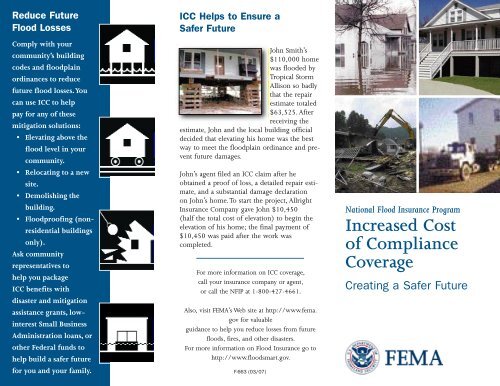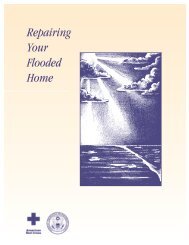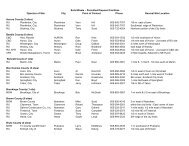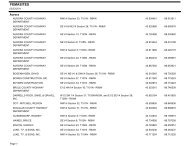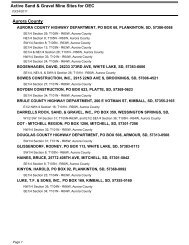Increased Cost of Compliance Coverage
Increased Cost of Compliance Coverage
Increased Cost of Compliance Coverage
Create successful ePaper yourself
Turn your PDF publications into a flip-book with our unique Google optimized e-Paper software.
Reduce Future<br />
Flood Losses<br />
Comply with your<br />
community’s building<br />
codes and floodplain<br />
ordinances to reduce<br />
future flood losses. You<br />
can use ICC to help<br />
pay for any <strong>of</strong> these<br />
mitigation solutions:<br />
• Elevating above the<br />
flood level in your<br />
community.<br />
• Relocating to a new<br />
site.<br />
• Demolishing the<br />
building.<br />
• Floodpro<strong>of</strong>ing (nonresidential<br />
buildings<br />
only).<br />
Ask community<br />
representatives to<br />
help you package<br />
ICC benefits with<br />
disaster and mitigation<br />
assistance grants, lowinterest<br />
Small Business<br />
Administration loans, or<br />
other Federal funds to<br />
help build a safer future<br />
for you and your family.<br />
ICC Helps to Ensure a<br />
Safer Future<br />
John Smith’s<br />
$110,000 home<br />
was flooded by<br />
Tropical Storm<br />
Allison so badly<br />
that the repair<br />
estimate totaled<br />
$63,525. After<br />
receiving the<br />
estimate, John and the local building <strong>of</strong>ficial<br />
decided that elevating his home was the best<br />
way to meet the floodplain ordinance and prevent<br />
future damages.<br />
John’s agent filed an ICC claim after he<br />
obtained a pro<strong>of</strong> <strong>of</strong> loss, a detailed repair estimate,<br />
and a substantial damage declaration<br />
on John’s home. To start the project, Allright<br />
Insurance Company gave John $10,450<br />
(half the total cost <strong>of</strong> elevation) to begin the<br />
elevation <strong>of</strong> his home; the final payment <strong>of</strong><br />
$10,450 was paid after the work was<br />
completed.<br />
For more information on ICC coverage,<br />
call your insurance company or agent,<br />
or call the NFIP at 1-800-427-4661.<br />
Also, visit FEMA’s Web site at http://www.fema.<br />
gov for valuable<br />
guidance to help you reduce losses from future<br />
floods, fires, and other disasters.<br />
For more information on Flood Insurance go to<br />
http://www.floodsmart.gov.<br />
F-663 (03/07)<br />
National Flood Insurance Program<br />
<strong>Increased</strong> <strong>Cost</strong><br />
<strong>of</strong> <strong>Compliance</strong><br />
<strong>Coverage</strong><br />
Creating a Safer Future
Flood Insurance Includes<br />
an Additional Way to Help<br />
You Rebuild.<br />
<strong>Increased</strong> <strong>Cost</strong> <strong>of</strong> <strong>Compliance</strong>, or ICC, coverage<br />
is part <strong>of</strong> most Standard Flood Insurance Policies.<br />
Claims for ICC benefits are filed separately from<br />
your claim for contents or building loss.<br />
If eligible, you can collect up to $30,000 to help<br />
cover the cost <strong>of</strong> bringing your home or business<br />
into compliance with floodplain ordinances. If<br />
your building has been repeatedly or severely damaged<br />
by flooding, your local floodplain ordinances<br />
may require you to make changes to the property.<br />
You can use ICC benefits to help pay for these<br />
required improvements.<br />
Are You Eligible to File<br />
an ICC Claim?<br />
You are eligible to file for ICC if your community<br />
floodplain administrator determines one <strong>of</strong> the following:<br />
• Your property is “substantially damaged.” This<br />
means that your community says the cost to<br />
repair your flooded building is 50% or more<br />
<strong>of</strong> its pre-disaster market value.<br />
• Your property sustained “repetitive damage.”<br />
This term applies to homes or businesses that<br />
were damaged by flooding twice in the past<br />
10 years, where the cost <strong>of</strong> repairing the flood<br />
damage, on average, equaled or exceeded 25%<br />
<strong>of</strong> the property market value at the time <strong>of</strong><br />
each flood. Also, there must have been flood<br />
insurance claim payments for each <strong>of</strong> the two<br />
flood losses, and the community’s floodplain<br />
management ordinance must have a repetitive<br />
loss provision.<br />
1 Report flood loss to insurer.<br />
4 Provide the building department’s<br />
written determination<br />
<strong>of</strong> substantial damage<br />
or repetitive loss to the<br />
adjuster.<br />
6 Obtain a signed contract<br />
that details costs to perform<br />
the mitigation activity<br />
and give it to the claims<br />
representative.<br />
8 Provide Pro<strong>of</strong> <strong>of</strong> Loss<br />
and copy <strong>of</strong> community<br />
permit(s) to the adjuster<br />
in order to receive the first<br />
portion <strong>of</strong> the ICC claim<br />
money.<br />
10 Complete the mitigation<br />
measure within 2 years<br />
from the date <strong>of</strong> loss.<br />
12 Provide a copy <strong>of</strong><br />
Certificate <strong>of</strong> Occupancy to<br />
the insurer.<br />
<strong>Increased</strong> <strong>Cost</strong> <strong>of</strong> <strong>Compliance</strong> Claim Process<br />
Policyholder Adjuster/Claims Representative Local Building Department<br />
2 Estimate flood damage and<br />
tell policyholder he/she<br />
may be eligible for ICC benefits.<br />
5 Set up an ICC claim file:<br />
Obtain damage and market<br />
value information on building<br />
from policyholder. For a<br />
repetitive loss building, get<br />
previous claim information.<br />
Verify that the flood-related<br />
damage for the current<br />
building claim supports<br />
community information.<br />
7 Provide Pro<strong>of</strong> <strong>of</strong> Loss form<br />
to the policyholder for a<br />
partial payment.<br />
9 Provide initial ICC claim<br />
payment to the policyholder.<br />
13 Make final ICC claim<br />
payment upon receipt <strong>of</strong><br />
Certificate <strong>of</strong> Occupancy.<br />
3 Determine building “substantially<br />
damaged” or a<br />
“repetitive loss.” Provide<br />
written determination to<br />
policyholder.<br />
Discuss mitigation options<br />
that will comply with floodplain<br />
regulations.<br />
Issue necessary building<br />
permits for mitigation measures.<br />
11 Inspect completed mitigation<br />
work and issue a<br />
Certificate <strong>of</strong> Occupancy or<br />
other written evidence that<br />
the work is compliant with<br />
floodplain management<br />
ordinances.<br />
Note: When participating in a community-sponsored, FEMA-funded mitigation project, the policyholder may assign ICC benefits to the community to integrate into the project.<br />
The community then becomes responsible for submitting all <strong>of</strong> the appropriate paperwork.<br />
Sequence <strong>of</strong> events may vary.


